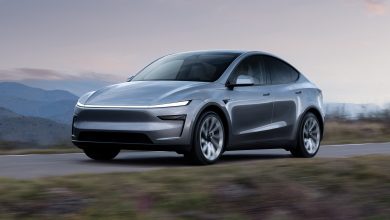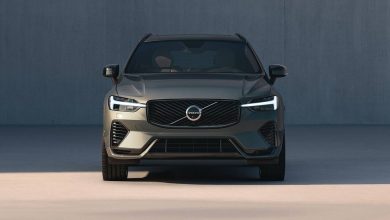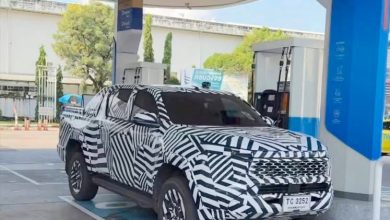All New 11th Generation Honda Civic Officially Revealed
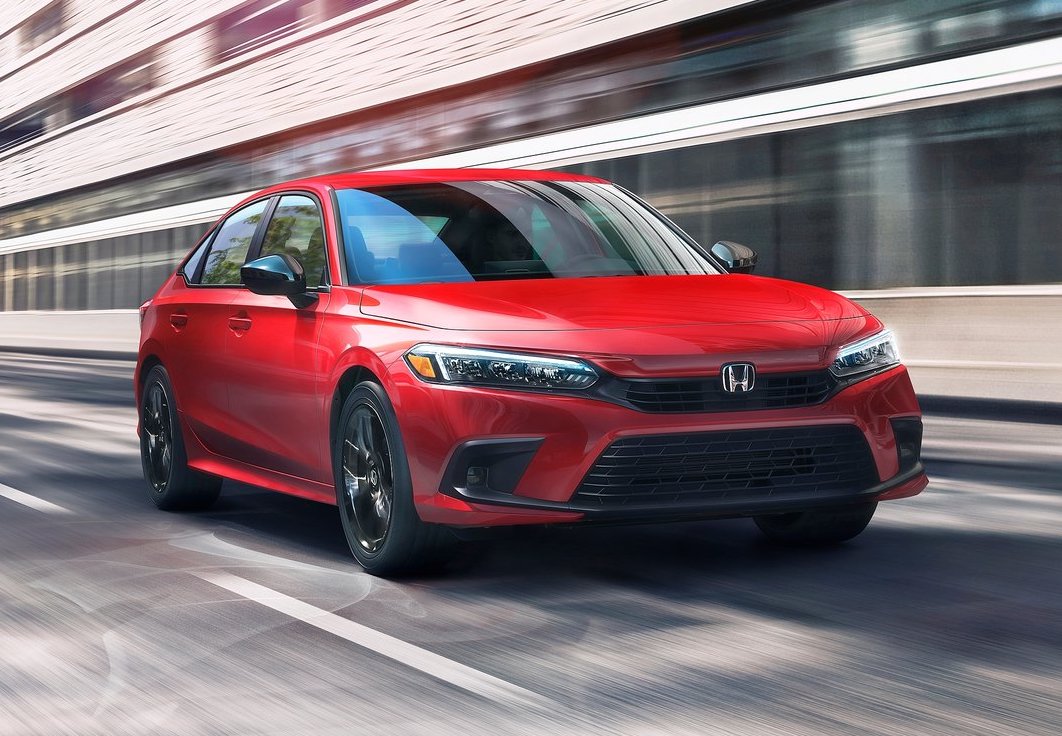
This new Civic is claimed by Honda to be its most technologically advanced and most fun iteration yet.
Honda has recently officially launched its all new 11th generation Civic. Despite having supposedly grown up from its prior iteration by sporting a more mature design and a whole load more tech, the Japanese automaker nevertheless promises that this latest iteration in its longest running model nameplate to date is also the most fun to drive in its nearly 50 year history.
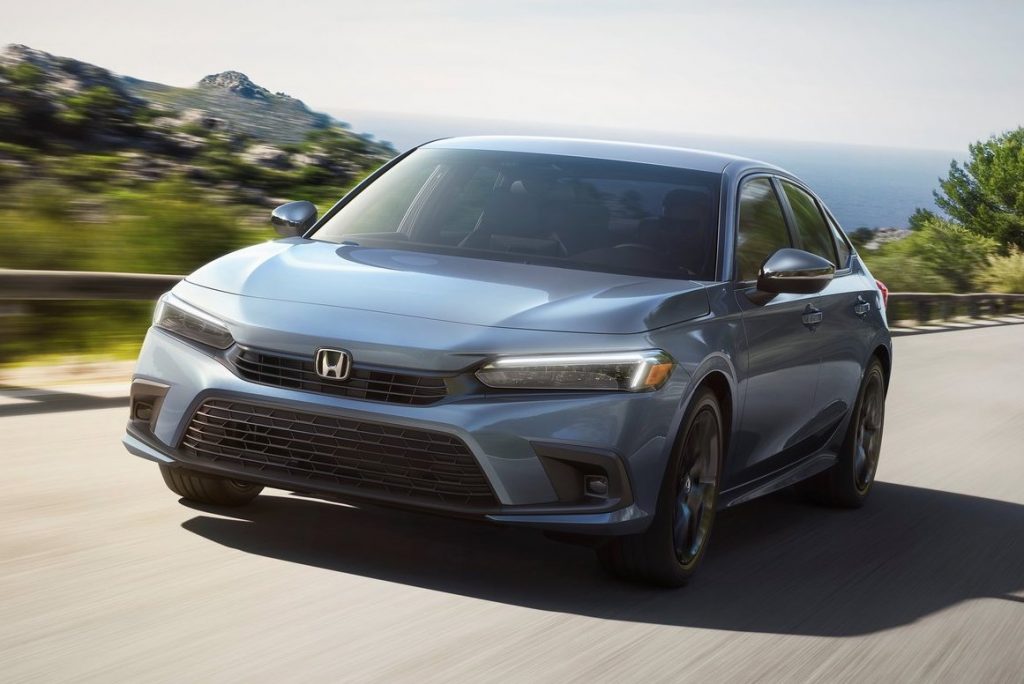
Starting first with the changes made to the skin of this 11th generation Civic first, it has grown by some 3.5 cm in wheelbase as compared to its predecessor. In terms of its exterior design meanwhile, this all new iteration also loses some of the more outlandish aspects of the outgoing model.
Bearing Honda’s new Man Maximum/Machine Minimum (M/M) design concept that was first previewed back in November, this new Civic instead features instead a more sedate, straight edged exterior aesthetic in contrast to its Gundam-esque predecessor. Coming complete with a cleaner front end design featuring more rectangular LED headlights flanking a simpler front fascia, a sleeker side profile made livelier by alloy wheels of up to 18-inches in diameter, as well as a rear end look that is more than a bit reminiscent of the current Accord.
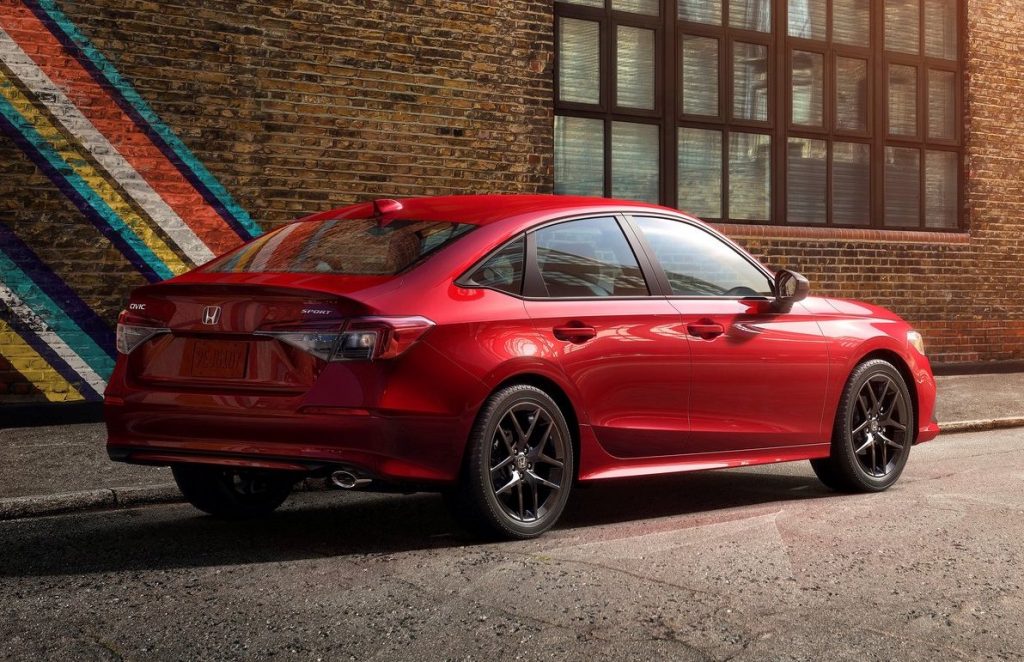
This straight-edged design has also been carried over into the cabin of the all new Civic, as demonstrated by its cleaner dashboard layout over the old model. Though the bigger story within the interior would be all the new tech that has been added within this sedan, which includes kit like a 10.2-inch all-digital LCD instrument display, a 7-inch (or 9-inch in higher-end variants) floating infotainment display with Apple CarPlay and Android Auto integration, not to mention Qi-compatible wireless charging and even a Bose surround sound system that is to be available in the flagship Touring trim level.
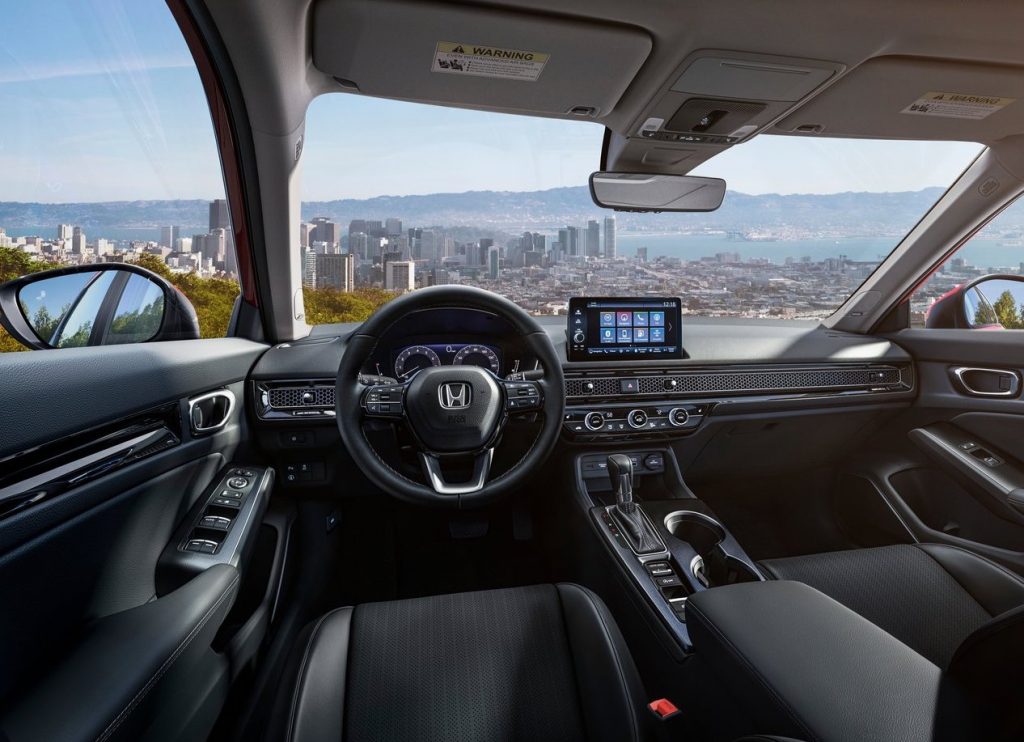
Being typical sensible Honda too, there have been other more subtle enhancements to make the inside of the Civic a much better place to be. Such changes include the addition of a 0.8-inch finger rest at the bottom of the touchscreen to make it a little easier to use and new front seat design utilising the Japanese automaker’s ‘Body Stabilizing Seat approach’ that supposedly ‘firmly holds the body, enhancing comfort on long drives’.
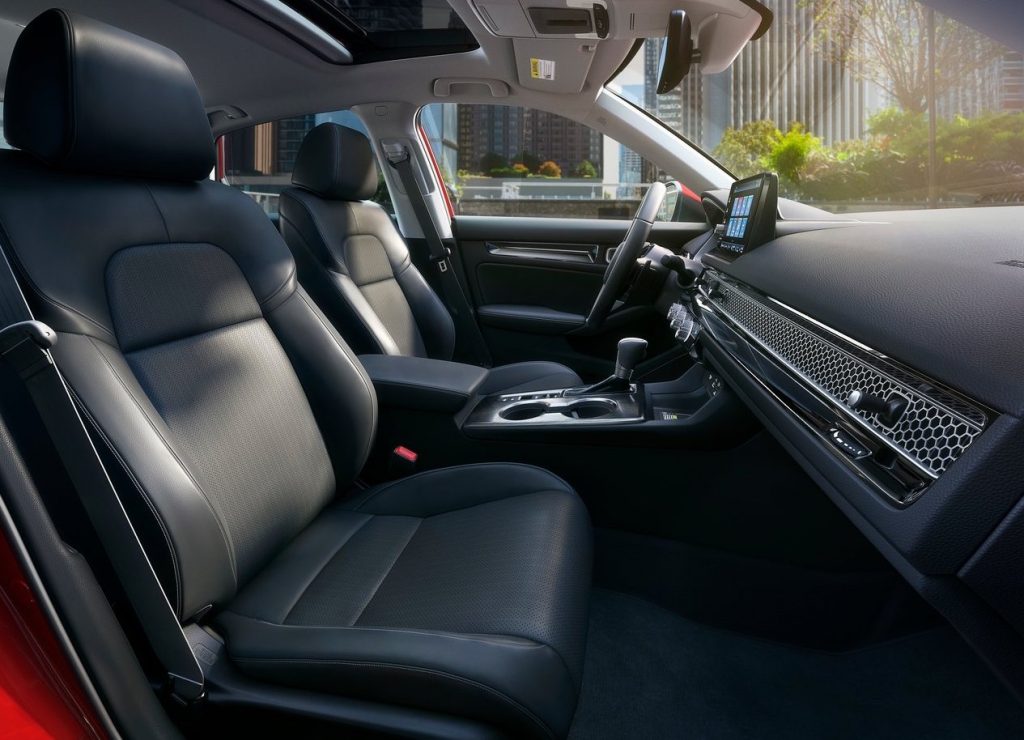
The new Civic also apparently features the use of more premium materials on throughout the interior, with it being most apparent in the striking metal honeycomb mesh accent that stretches ‘from door to door across the dash’. Joy of joy too, Honda has reinstated physical HVAC and volume control knobs with this latest iteration.
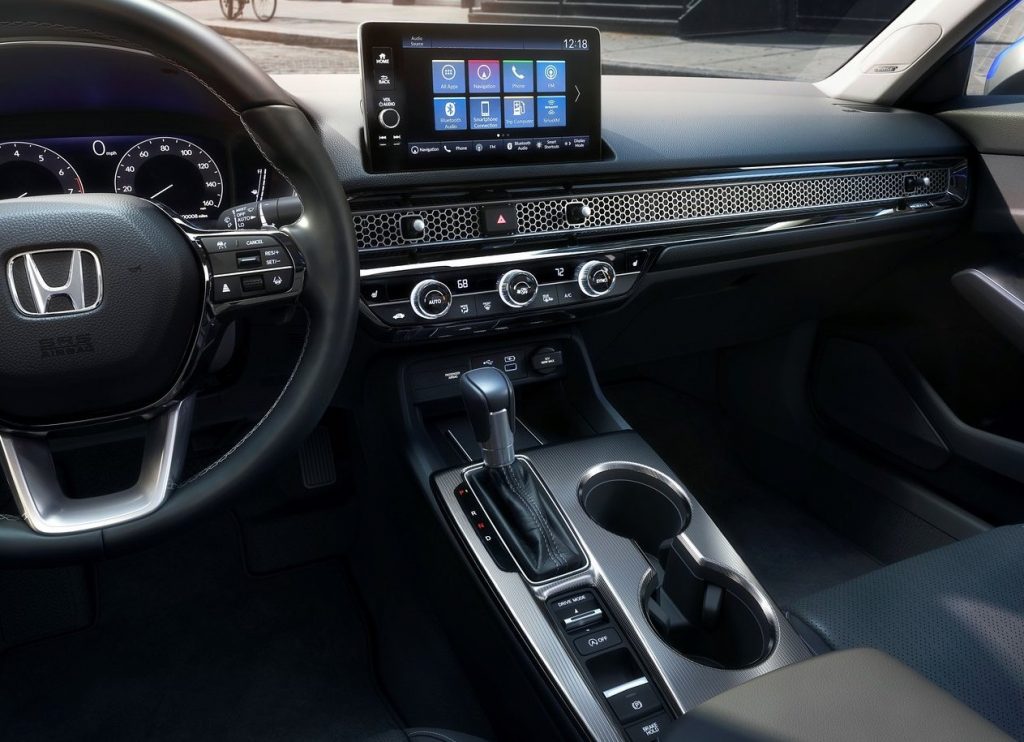
As for further changes under the skin of the new Honda, this latest iteration brings with it a host of suspension and steering upgrades that have been claimed to ‘result in a smoother, more linear and more precise feel in turns’. A wider rear track (by 1.3 cm), an all-new aluminium front subframe and what has been touted to be the stiffest chassis in the Civic’s history on the other hand steers this new model into more grown up territory by supposedly offering better NVH suppression and on-road stability for a more relaxed and comfortable driving experience.
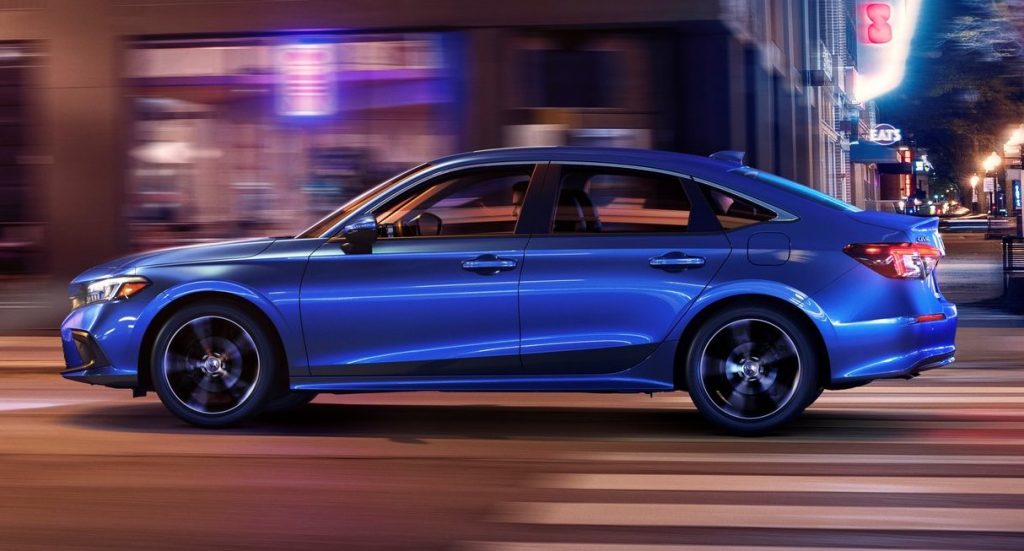
Speaking of driving experiences, this new Civic should also offer a safer one too courtesy of all the new safety kit that has been made available. On the active safety front, the Honda Sensing active safety suite has been upgraded with a new camera that can more quickly detect on-road hazards and added functionality such as Traffic Jam Assist, Low-Speed Braking Control in addition to front and rear false-start prevention.
On the passive safety front meanwhile, the Advanced Compatibility Engineering (ACE) body structure in this latest iteration has been enhanced further for even better crash compatibility with larger vehicles. The Civic also introduces a world-first frontal airbags that are designed to reduce brain injuries by better controlling the motion of the head during certain kinds of crashes.
Rounding off the details of this new Civic will be what lies under the hood, and that will be either a 2.0 litre naturally aspirated four-pot or a 1.5 litre turbocharged unit carried over from the current car. Mildly revised from its current form, both these engines will be mated to the sole option of a continuously variable transmission (CVT) that has been tweaked somewhat too to altogether offer improved power delivery, engine sound, overall refinement and fuel efficiency.
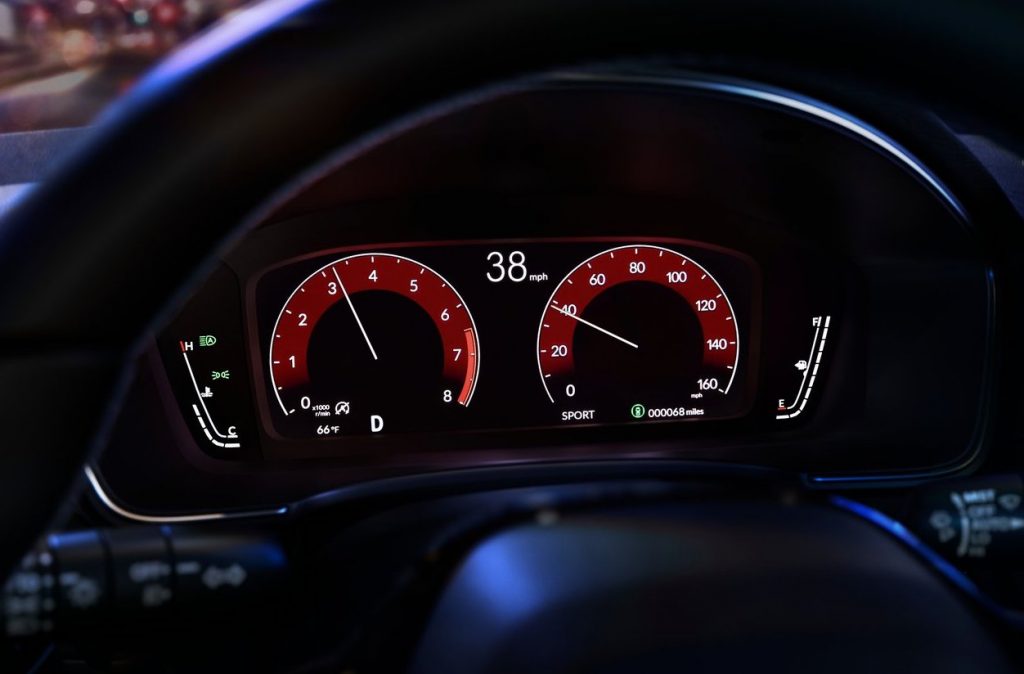
Set to go on sale in North America come summer of this year, this new Honda Civic is expected to be a touch more expensive than the outgoing model. As for when it will arrive in Malaysia, rumours suggest that we might actually amazingly see it over here by the end of this year.
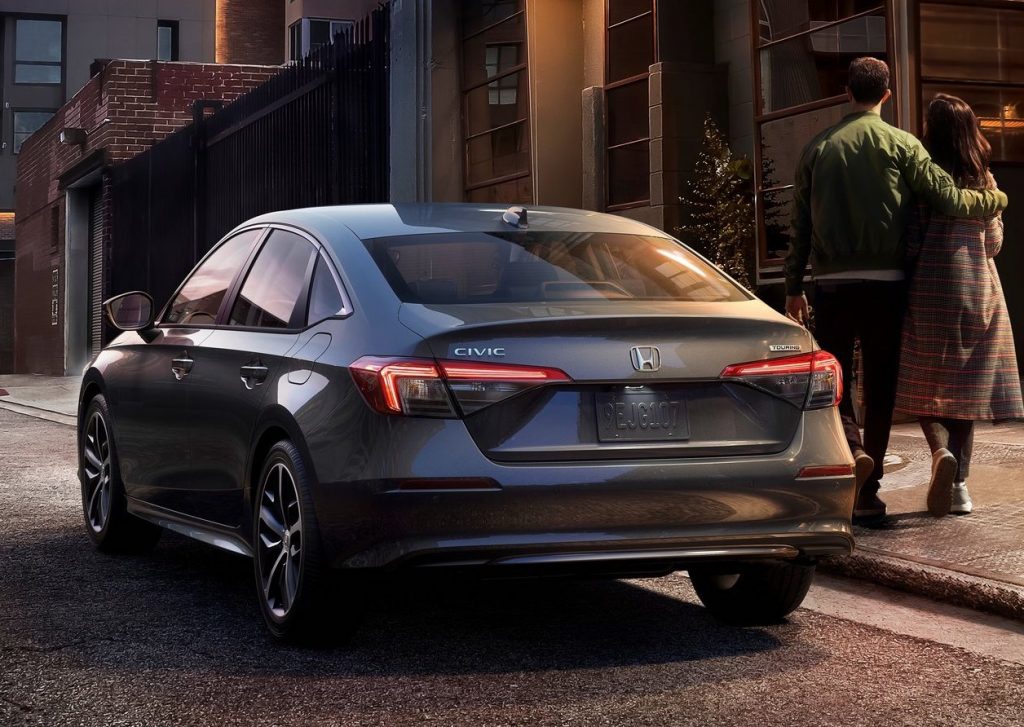
PRESS RELEASE: Honda today revealed the most fun-to-drive and technologically advanced Civic Sedan in the model’s nearly 50-year history. The all-new 2022 Honda Civic boasts a clean, modern design paired with a high-tech, human-centered interior, and equipped with advanced active and passive safety systems. Previewed in November 2020 in prototype form, the 11th-generation Civic continues the tradition of innovation, design leadership and class-leading driving dynamics.
As Honda’s longest-running automotive nameplate, Americans have purchased more than 12 million Civics since 1973, making it one of the top three best-selling passenger cars in America over the past 48 years. With sales of more than 1.7 million units over the last five years, Civic has been the No. 1 model in America – car or light truck – with first-time buyers, Millennials, Gen Z and multicultural customers, since the launch of the 10th-gen model in 2015.
Man Maximum/Machine Minimum Philosophy
In designing the 11th-generation Civic, Honda stylists and engineers sought to create a car that would be a “breath of fresh air” in the segment by revisiting timeless design concepts of previous generation Civics. They focused on the original Honda design approach of “Man-Maximum, Machine-Minimum” (or “M/M”), which uses technology and design to serve the needs of the driver and passengers. The styling of the 2022 Civic manifests these timeless design concepts in a fresh and exhilarating new way.
A “thin and light” body design with a low hood and front fenders, and a low horizontal beltline grounds the body, accentuates the wheels and tires, and enables an expansive, airy greenhouse. Inside, the M/M approach results in a strikingly simple, clean and modern take on classic Civic values. By evoking the uncluttered cabin design of early generations of Civic, the new model’s interior features exceptional visibility, intuitive ergonomics, extraordinary passenger volume and driver-focused technology.
Exterior Design
Key to the new Civic’s upscale styling was moving the bottom of the windshield pillars rearward by nearly 2 inches (1.96 inches), which elongates its hood for a premium silhouette. This also visually connects the pillar to the front wheel hub, a subtle design element that emphasizes its wheels and tires for a stable, planted stance.
A low beltline with horizontal windowsills and door-mounted side mirrors improve visibility while maintaining the clean lines of the exterior. A sharp shoulder character line carves a gentle arc from the front fender to the taillights, giving continuity to the design. The lower character line carries up from the bottom of the front door, rising across the rear doors, and through the rear fenders for an enhanced sense of motion.
The additional stability provided by its new wider rear track is emphasized by stronger rear shoulders, wide-set LED taillights, and the upswept and aerodynamically efficient trailing edge of its trunk lid.
LED lighting is used extensively for the exterior, including the wide-set headlights, daytime running lights, parking lights, and available fog lights.
The Civic Sedan will be available in eight exterior colors, three of which are new: Meteorite Gray Metallic, Sonic Gray Pearl and all-new Civic-exclusive Morning Mist Blue Metallic.
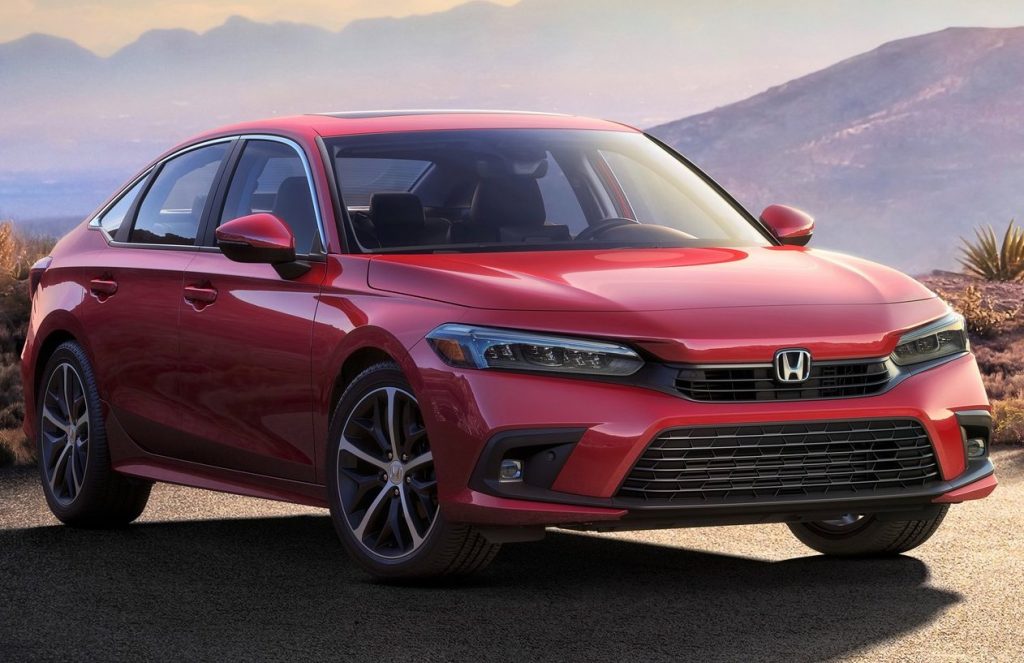
Human-Centered Interior Design
Honda’s outstanding interior packaging results in ample head, leg, shoulder and hip room for all passengers. A feeling of spaciousness is immediately felt and shared by all Civic occupants, thanks to the low, flat beltline and uncluttered design throughout its cabin.
The pulled-back A-pillars, low hood, flat dashboard and hidden windshield wipers enable a windshield with clearly defined corners for a panoramic view. The low cowl is the same height as the door sills for an uninterrupted and harmonious flow that extends from the dash all the way to the rear doors. The outside mirrors also have been positioned away from the windshield pillars to improve visibility.
Further improving visibility is the top of the Civic’s instrument panel, which has been designed with minimum cutlines to reduce windshield reflections and visual distractions.
A striking metal honeycomb mesh accent stretches from door to door across the dash. It serves both form and function, creating a dramatic visual dividing line between the audio, information displays and the climate controls, while the intricate flow-through design conceals the air vents that would otherwise mar the uncluttered and harmonious look of the dash.
High-quality materials are used throughout the interior, especially on touchpoints, with close attention paid to the operation of all switchgear and controls. Materials were also chosen with an eye toward practicality, such as the new premium center console trim specifically designed to hide fingerprints and smudges to help maintain a high-end appearance.
All Civic trims benefit from a new front seat design. Using Honda’s Body Stabilizing Seat approach, the new-generation seat frame firmly holds the body, enhancing comfort on long drives.
Driver Focused Technology
Technology has also been smartly integrated with the M/M approach. For the first time, all Civic trims have either a partial or full (Touring) digital instrument display while gaining notably larger standard and available color touchscreens.
LX, Sport and EX grades are equipped with a 7-inch color LCD instrument display similar to that found in Accord. An all-digital speedometer and tachometer are on the left side of the instrument panel, while a physical speedometer dial occupies the right side.
Touring models are graced with Civic’s first all-digital LCD instrument display. Measuring 10.2 inches, the high-definition full-color LCD panel displays a variety of information, all customizable from the steering wheel. The custom modes include showing gauges in a traditional round needle-and-dial, or bar graphs flanking the left and right of the screen. In the middle is a variety of user-selectable information, such as the current music selection and a trip computer, with the center of the display used to indicate the status of various Honda Sensing® safety and driver assistive systems. In a surprise-and-delight feature, the brake lights, headlights and turn signals of the displayed Civic vehicle image turn on and off with those functions.
LX, Sport and EX grades come standard with a new 7-inch color touchscreen, the largest standard screen in Civic history. Functionality is improved by the addition of both a physical power/volume knob and a tuning/selection knob. At the bottom is a row of hard buttons for skipping music tracks, navigating the audio menu, and selecting between phone, radio, Bluetooth® or USB media, or a connected smartphone for use with Apple CarPlay® and Android Auto™.
Civic Touring also debuts an all-new 9-inch color touchscreen, which builds upon the foundation laid by the Display Audio system in Honda models such as Accord, Odyssey, Pilot and Passport. The new touchscreen is the largest ever in any Honda-brand vehicle, and features a physical volume knob, large, easy-to-recognize icons, and a simplified navigation structure with fewer embedded menus. On the left are hard buttons for Home and Back functions.
Other mode selections are at the bottom of the touchscreen, with a 0.8-inch finger rest making it easier to use the touchscreen by providing a stable surface to rest your hand. The touchscreen systems also come standard with wireless Apple CarPlay® and Android Auto™ integration, while Touring comes standard with Qi-compatible wireless charging.
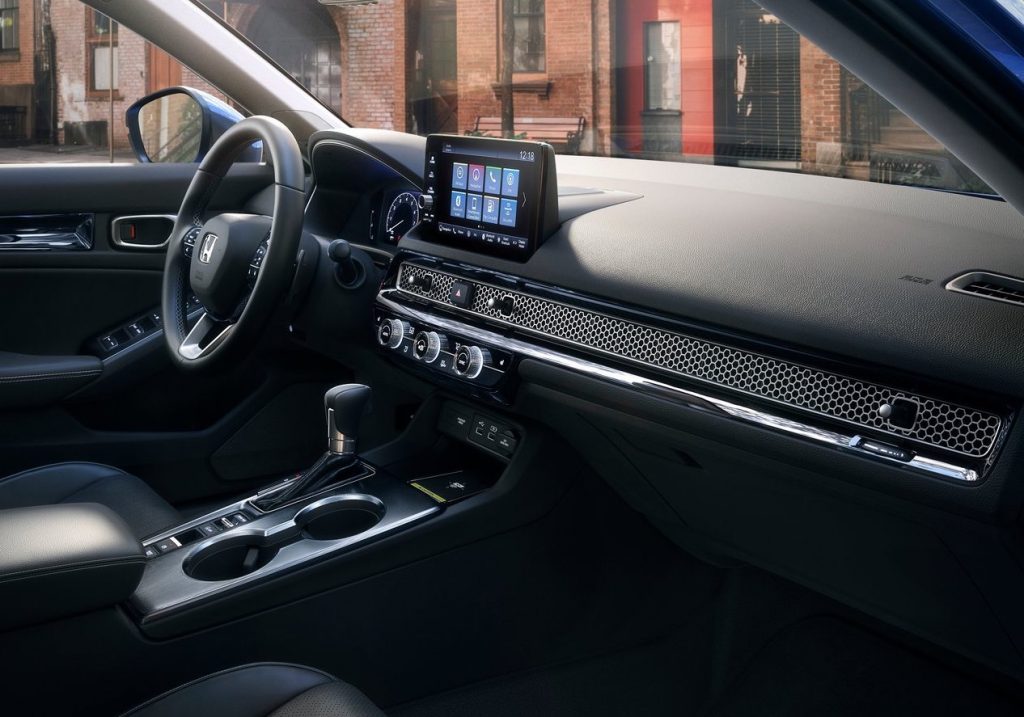
Civic First Bose Premium Sound System
Touring trims also feature the first use of Bose audio in a Civic. With Bose Centerpoint 2 and Bose SurroundStage digital signal processing, the new system was custom-engineered precisely for the Civic’s new interior so drivers and passengers – regardless of their seating position – are placed in the middle of the music, with a clear and spacious listening experience for all audio content.
Expert audio engineers developed the Bose sound system with advanced components and technologies, working closely with Honda engineers to integrate the system early in the vehicle design process for optimal performance. Clear, impactful sound is delivered through high-performance Bose speakers, strategically placed throughout the Civic’s interior for exceptional music reproduction across all frequencies, low to high.
Helping to preserve the quality of the listening experience, Dynamic Speed Compensation technology automatically adjusts volume and tone based on vehicle speed, reducing the need for drivers to manually adjust settings while on the road.
Stiffer Body Structure Improves Dynamics and Safety Performance
The 11th-generation Civic body structure is the most rigid in Civic history, with an 8 percent improvement in torsional rigidity and 13 percent improvement in bending rigidity versus the previous generation. The stiffer structure supports improvements in ride, handling and NVH.
The next generation of Honda’s Advanced Compatibility Engineering™ (ACE™) structure is designed to meet present and anticipated future collision standards while minimizing additional weight. This is achieved with the extensive use of lightweight materials, such as aluminum and various grades of high-strength steel, as well as an expanded application of structural adhesives.
The new, stiffer body also reduces the transmission of road and wind noise to create a more relaxed driving environment.
Fuel Efficient, Powerful Drivetrains
Like the outgoing Civic, two 4-cylinder engines will be available for the 2022 model: A naturally aspirated 2.0-liter or a turbocharged 1.5-liter. Both are paired with an updated continuously variable automatic transmission (CVT) uniquely tuned for each engine. Power delivery, engine sound, overall refinement and EPA fuel economy ratings of both engines are improved, with the 1.5L also getting a boost in power output.
Standard in LX and Sport trims, the 2.0-liter 4-cylinder produces 158 horsepower @ 6,500 rpm (SAE net) and 138 lb.-ft. of torque @ 4,200 rpm (SAE net). Due in part to a new standard idle-stop system and a new catalytic converter design, fuel efficiency and emissions are notably improved. The revised CVT enhances fuel efficiency by using more robust electric hydraulic pump which reduces the load on the mechanical pump, and a ball-bearing secondary shaft to reduce friction. Also, the transmission has been programmed to provide early downshifts during braking and features revised Step-Shift programming that simulates physical gear changes under hard acceleration for a more familiar and enjoyable driving experience.
For EX and Touring trims, the 1.5-liter turbo 4-cylinder produces 180 horsepower @ 6,000 rpm (SAE net) and 177 lb.-ft. of torque at 1,700 to 4,500 rpm (SAE net) on 87 octane gasoline, up 6 hp and 15 lb.-ft. of torque from last model year. Multiple measures contribute to improved fuel economy ratings, including new more efficient turbo plumbing and the addition of Variable Timing and lift Electronic Control (VTEC®) to the exhaust valves. The CVT for the 1.5-liter turbo features improved torque converter performance, while also adopting revised Step-Shift programming.
In addition to the standard Normal and Eco driving modes, 2.0L Sport and 1.5L Touring trims of the 2022 Civics now feature a user-selectable Sport mode. Using a toggle switch on the center console, the new Sport mode alters the drive ratios and mapping for a sportier feel, and changes the meter lighting to red. Eco mode reduces throttle and transmission sensitivity, as well as air conditioning output to help preserve fuel efficiency.
Chassis Tuned for Responsiveness, Fun and Comfort
Civic’s suspension has been carefully tuned to take maximum advantage of the stiffer body structure and additional 1.4-inches of wheelbase for a smoother ride, while improving the benchmark sporty handling for which Civic has long been recognized.
The front MacPherson struts feature new low-friction ball joints and front damper mount bearings to improve steering feel and self-centering, and the spring and damper alignment has been optimized to minimize operational friction.
In the rear, the track is 0.5-inch wider for enhanced stability, with a new larger compliance bushing with an improved bushing axis to minimize harshness. Additionally, the two rear lower arms are equipped with a new bushing that reduces noise and vibration inside the cabin, while also promoting better straight-line stability and turn in. The electronic power steering has been re-tuned to provide better feedback and improved straight-line stability.
New low-drag front brake calipers and low-friction front and rear wheel bearings reduce rolling resistance and help improve fuel economy ratings.
An all-new and lighter aluminum front subframe with an efficient truss and rib structure provides rigidity and stability. Additionally, a new lightweight flex tube in the exhaust system decreases noise transmission.
The suspension and steering upgrades result in a smoother, more linear and more precise feel in turns, with the reduction in yaw delay leading to a more responsive and synchronized feeling behind the wheel. Additionally, the reduced suspension friction and improved bushings help reduce harsh road shock, such as when going over railroad crossings, by 20 percent.
Advancing Small-Car Safety Performance
Continuing the Civic’s longstanding tradition of advancing small-car safety performance, the 2022 Civic introduces multiple new active and passive safety systems. In a world’s first application, both driver and passenger frontal airbags in the 2022 Civic are designed to better reduce conditions associated with brain injury by better controlling head motions in certain types of crashes. Similar in intent to the passenger front airbag technology featured in the 2021 Acura TLX and 2022 Acura MDX, these all-new airbag designs attempt to address the recently recognized issue of severe brain trauma associated with angled frontal collisions. The new front driver’s airbag uses an innovative donut-shaped structure to cradle and hold the head to reduce rotation. The passenger-side front airbag uses a three-chamber design to achieve a similar result, with two outer chambers designed to cradle and control head rotation.
The Advanced Compatibility Engineering™ (ACE™) body structure in the new Civic has been enhanced for even better compatibility with larger vehicles. This includes improved occupant protection in angled frontal collisions, with a new upper A-pillar structure, side frame and lower firewall structure—all designed to route crash energy around the cabin. Side impact protection also has been improved, with stiffer structures in the roof, side sill and B-pillar, doors, and the rear wheel arch and C-pillar.
The standard Honda Sensing® suite of active safety and driver assistive technologies uses a new single-camera system that provides a wider field of view than the previous radar-and-camera based system. Combined with software advances and a new, more powerful processor, the system is also capable of more quickly and accurately identifying pedestrians, bicyclists and other vehicles, along with road lines and road signs.
Honda Sensing® has been further enhanced with expanded driver-assistive functionality. The system now adds Traffic Jam Assist, and the new camera-based system improves on existing functionality, such as more natural brake application and quicker reactions when using Adaptive Cruise Control (ACC). It also has more linear and natural steering action when using the Lane Keeping Assist System (LKAS). With the addition of eight sonar sensors, Civic, for the first time, features Low-Speed Braking Control, and front and rear false-start prevention.
Honda leadership in advancing pedestrian safety continues. The 2022 Civic features a new front bumper beam safety plate designed to decrease leg injuries and a hood with an embossed inner structure designed to improve head protection performance.

